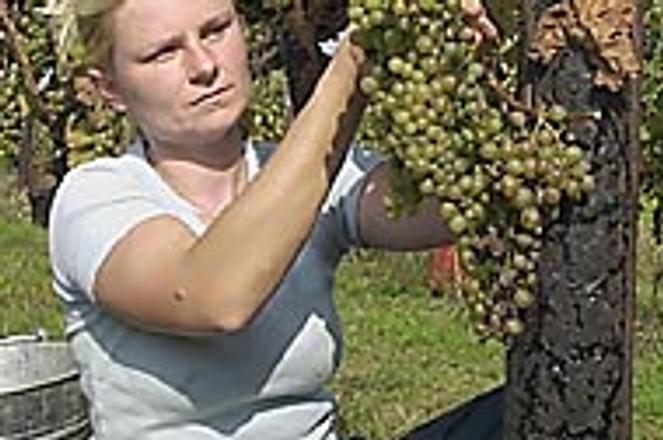Producers of Tokaj wine have benefitted from the foundation's money and expertise.photo: TASR
KOŠICE - The Carpathian Mountains region has traditionally been one of Europe's great cultural melting pots. Covering some 140,000 square kilometres, the land of Dracula is home to over 14.7 million people, eight different languages and five major religions.
It is also the poorest region in modern Europe. Including eastern Slovakia and proximate regions of Poland, Ukraine, Hungary and Romania, the Carpathians have the highest birth-rate on the continent, the highest migration rate, plus the biggest European Roma population.
What is more, the once unified geographic region is today dissected by a slew of national borders, complicating international cooperation and further isolating nearly forgotten villages. Which is where the eastern Slovakia-based Carpathian Foundation enters the picture.
"The Carpathian Mountain region is the least served area in Europe. It is the chicken yard of Europe," said Sándor Köles, the executive director of the Carpathian Foundation.
"We promote cross-border cooperation by providing financial support to local organisations, governments and NGOs to help them handle high poverty and the social change caused by people leaving the region," he said.
The Carpathian Foundation was launched in 1994 as a project of the East-West Institute. It became independent in 2000 and last year subsisted largely in thanks to a $1 million grant by the Charles Stewart Mott Foundation.
The non-profit organisation donates the money it was given in part to promote 'rural development', thereby making life in the neglected Carpathian countryside possible. Last year the foundation doled out grants totalling $917,000. "Rural development does not mean turning villages into cities, but rather making life there feasible," said Aaron Chase, a programme director.
"These regions are the poorest in their respective countries, and they are very far away from the capital cities making the decisions that affect them. The Carpathian regions in Romania and Ukraine, for instance, are very far away from Bucharest and Kiev," added Köles.
To receive financial aid, applicant organisations are required to submit a project proposal. Winners receive grants to carry out their programmes; typically, one programme per selection round in each country is financed by the Carpathian Foundation.
"The applicants decide what they want to do themselves. They submit a proposal showing how they would use a chunk of money in order to create a more sustainable life in their villages," Chase said.
Programmes supported by the Carpathian Foundation take various forms. For example, Hungary's Tokaj region was in 1997 granted $50,000 for a three-year programme aimed at promoting wine-tourism and aiding small producers of the area's famous sweet Tokaj wine.
"The local governments received the money with the idea of revitalising the wine industry in the Tokaj region [80% of which is in Hungary, 20% in Slovakia]. Several hundreds of years ago, there was a rich wine-making tradition there, but it has suffered," said Köles.
Tokaj production's first serious blow came in 1885 when a bug destroyed 75% of local vineyards. After a gradual comeback, the vineyards were again damaged by the bombs and battles of World War II. Forced collectivisation during communism further ailed production, as did the socialist market collapse of 1989.
"Then westerners began introducing different wine-making styles that went against tradition, which is why the programme aims at aiding small wine-makers who preserve the original Tokaj-making ways," said Köles.
As a result of the programme, several Tokaj festivals have been established, attracting tourism and providing markets for small producers. Tokaj festivities culminate each August with the Borut Wine Road celebration, a 15-day travelling event that follows a path north from Tarcal, Hungary to Košice in Slovakia and Krakow in Poland.
In Slovakia, the first Carpathian Foundation-funded programme was called Villages for the Third Millennium, also a three-year project which in 1997 received $160,000. Managed by the Košice-based NGO Ľudia a Voda (People and Water), the project successfully fought the planned construction of a dam near the eastern Slovak village Lipany by proving it unnecessary.
The dam, which had been proposed some 40 years before, had prevented locals from devising a local development programme while their villages awaited submersion. Last year, the Association of Towns and Villages in the eastern Slovak Vranov region was awarded $100,211 for a campaign aimed at increasing local awareness of the region's potential.
The project hopes to fight the ever-increasing migration of the region's educated youth for job opportunities in the West.
Other projects include the promotion of wooden church tourism in Poland's 'Track of Icons', and the establishment of a tourist track following the path of the famous Czech literary character 'Good Soldier Švejk'.
To ensure the Carpathian Foundation's continuance, it is pursuing an endowment programme based on a 'challenge grant' of $5 million from the Mott Foundation, meaning that the foundation would receive the grant only after it raised an additional $5 million from other sources.
The endowment, it is hoped, will provide a financial base allowing the foundation to operate in the region for years to come.
"This is a natural geographic region that is now divided by many political borders. That's why it is so important to promote cross-border cooperation," said Köles. "When you meet westerners and you say you're from the Carpathian mountains, they think, 'Aha! Dracula!' But we'd like to present a different view of this region. This is one of the most interesting places in the world."
Donations to the Carpathian Foundation can be sent to Karpatská Nadácia, Hlavná 70, 040 01 Košice. Direct deposits can be made to VÚB bank, Strojárenská 11, Košice. Account number: 3542144-512/200.


